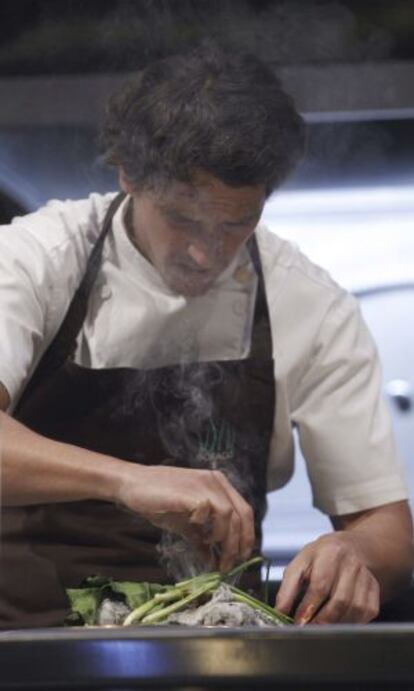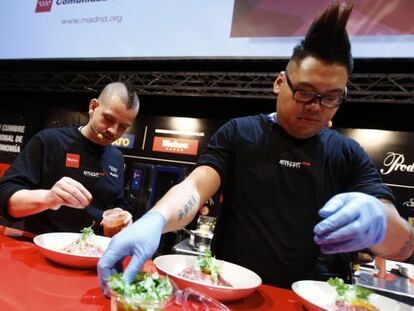Haute cuisine gets real
Madrid Fusión gastro summit sees chefs seeking delight among the everyday

At first it feels more like Madrid Confusion. The venue, the Spanish capital’s Palacio Municipal de Congresos, is a twisted mindscape of floating floors and escalators seemingly to nowhere. And security at Madrid Fusión — last week’s annual gastro summit that draws chefs, industry insiders and frenzied foodies from Spain and across the globe — is tight. To enter each area of the conference, you have to be scanned in. To leave each area, you have to be scanned out. Fail to scan out and you’re left in limbo.
“You can’t go in,” said the security guard, scanning the barcode on my badge. I was trying to get into a room I’d forgotten to scan out of.
“Why not?” I asked.
“Because you’re already inside.”
Having your reality challenged is an appropriate way to kick off a conference on modern haute cuisine. In this post-Ferran Adrià world of foams, spheres and olives that aren’t quite what they seem, top-flight chefs might seem more Albert Einstein (or Uri Geller, depending on your point of view) than Paul Bocuse. Which is why this year’s Madrid Fusión was a breath of fresh air. Under the long-winded battle cry “Eating in the City: Inspiration is in the Street,” the conference mooted that high-class cooking, after having its head down in the lab, is finally coming home.
We want to map every herb, every flower and to know the best time to pick them”
“To discover tomorrow’s cuisine, we have to return to the food of yesterday,” said French chef Michel Bras from the stage on day two. “The less we have, the stronger our ability to create will be.” Bras’ call for simplicity was echoed by the many Spanish and foreign chefs during the conference’s three days of talks and cooking demonstrations.
Restaurants touted their vegetable gardens (at Azurmendi, a three-Michelin-star haven in the Basque countryside, diners tour the tomato plants before taking their seats) and farmers and fishermen are the new heroes. “We have to eat what the fisherman catch, not demand they catch certain fish,” said Belgian chef Filip Claeys, who has put by-catch on the menu to support the local fishing community and ecosystem. “Often these unwanted fish are as good as, or tastier than, the popular species.”
While the back-to-basics approach could have come off as trite and too clearly contrived to chime with these straitened times, the chefs seemed at ease and liberated by the move to make haute cuisine more human.
Most inspiring was Joan Roca, head chef at Spain’s El Cellar de Can Roca, who unveiled his 18-month-long labor of love to locate and categorize the wild plants of his native Girona (which is also where his restaurant is located). His grandmother, he said, cooked with local plants, and Roca wants to recover that knowledge. “We’re rediscovering our surroundings… We want to map every herb, every flower and to know the best time to pick them.” The edible ones — even invasive species — are winding up on diners’ plates. More ambitious is the work by three young Latin American chefs — from Peru, Bolivia and Chile — who, with newfound pride in their countries and contact with indigenous peoples, are rediscovering an entire local cuisine. Ingredients include grilled llama, dried alpaca heart, trout from 4,000-meter Andean lakes and, of course, a dash of coca. “Hopefully one day we’ll be serving this food to our children,” mused chef Rodolfo Guzmán of Boragó restaurant in Santiago, Chile.
Beyond the walls of the auditorium is the dark side of Madrid Fusión: the trade fair
If the touchy-feely tone meant proceedings were lacking a little irreverence, then thank god for David Muñoz. With his third Michelin star still settling in the firmament, the firebrand chef at Madrid restaurant DiverXo stormed the stage with his band of rebel cooks. To a thumping Chemical Brothers beat they jury-rigged a fully functioning replica of StreetXo, Muñoz’s accessibly priced central-Madrid “street food” bar, and cooked up an apocalypse. “Our food tastes of iron and fire,” hollered the mohawked ringleader, as his team dismembered live crabs, sautéed them amid furious flames and fed them to 10 wide-eyed (and eyebrow-charred) audience participants.
But even Muñoz’s cooking-as-theater was no match for the circus outside. Beyond the walls of the auditorium is the dark side of Madrid Fusión: the trade fair. And if the ruminations of top chefs are the heart of this event, the businesses and tourism bodies pushing their USPs on the conference room floor are the fat and gristle. Necessary, but not pretty. Gourmet freebies — cured Iberian ham, black truffle slithers and fighting bull tail canapés — are liberally tossed to the hungry crowd, and many attendees simply forage for their lunch. Come mid-afternoon it’s a lonely soul who isn’t cradling an on-the-house gin and tonic from the Beefeater stand or shooting a sherry cocktail in the name of research.
There was one person missing from this year’s event: Ferran Adrià. The high priest of haute cuisine hasn’t appeared at Madrid Fusión since 2011, a year after announcing at the conference the closure of his groundbreaking restaurant elBulli. But Adrià did appear via recorded video on the last day to present Bullipedia, a live digital cuisine encyclopedia for professional chefs. According to Adrià’s two lieutenants Oriol Castro and Eduard Xatruch (who were on stage), Bullipedia — to be released this year — will categorize, define and, in some cases, redefine, the ingredients and cooking techniques of western cuisine of the last half century.
“If I take a banana and give it to somebody, am I cooking?” Xatruch asked the audience. And, the pair asked, is an avocado a fruit or a vegetable? “Because for Spaniards it’s a vegetable, yet in South America it’s considered more of a fruit,” said Castro. Next Xatruch poured tomato juice into glass and took a sip. “This is a juice.” Then Castro tipped it into a bowl. “Now it’s a soup.” Finally Castro dumped the red liquid into a pot, mimed heating it over a stove and pouring it on pasta. “And now it’s a sauce.”
What do these insights mean for the future of cooking? Despite the generous applause, I doubt many in the audience had much of a clue. But after three days of chefs daring to make modern cuisine more real, there seemed to be a communal tingle of delight that Ferran had swooped in at the last minute and flipped the switch on our reality.








































